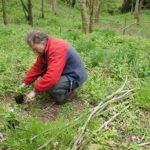 Keith’s story of the changes he is making to a patch of new woodland in Herefordshire.
Keith’s story of the changes he is making to a patch of new woodland in Herefordshire.
Seven years ago we acquired an acre of land adjoining our garden in rural Herefordshire. The land, on Old Red Sandstone clays, used to be pasture, then trees (mainly ash, with oak, cherry and field maple) were planted ten years previously. The ground flora was predominantly nettle, bramble, dock and coarse grasses. Adjoining this land on one side is an old lane with some residual woodland plants e.g. dog mercury, sweet violet & garlic mustard; on the other side is lightly grazed scrubby woodland with some lovely old ash and hawthorn and large patches of bramble/nettle and small patches of woodland flora.
We have seen many fields recently planted with trees where no woodland flora have established themselves in two decades. Therefore, we decided to try to speed up the process of creating true woodland from the ex-pasture with trees. Our strategy was over several years to:
- Thin out the ash (before we knew about Chalara fraxinea) and replant with under storey trees & shrubs e.g. holly, guelder rose, buckthorn, crab apple, dog rose, spindle, honeysuckle.
- Seed the area with hawthorn berries. Squirrels do this for hazel by burying their nuts everywhere.
- Cut back nettles and brambles, except 2 or 3 patches, remove other weeds such as docks and ragwort as they blow in from adjoining unmanaged pasture.
- Plant woodland flowers, of local origin, in clumps, in three main areas. e.g. wood sage, bluebell, wood sorrel, dog mercury, wood anemone, ramson, primrose, nettle leaved bellflower.
- Create log/brash piles for wildlife and leave two or three dense brambles patches.
This is where we are seven years later:
- The nettles, brambles and grass have largely gone & to our delight have been replaced by several woodland species that have come in with no help from us. These are wood avens, which covers much of the wood, red campion, male fern and celandine – carpeting parts of the wood in yellow in early spring.
- The woodland flowers we first planted established very slowly in the clay soil. We now add the leaf mould (we’ve
- When we first planted flowers/bulbs they did not grow well in the clay soil. We now plant them with our own leaf mould & they are now growing and spreading more quickly – looking forwards to having a wild garlic patch for use in the kitchen.
- Docks in particular have been a nuisance & so we have resorted to some spot weeding with glycophosphate.
- Hawthorn and hazel seedlings have sprouted and are growing throughout the wood. Planted trees are doing well, adding variety
- Bramble patches, gorse bushes and log/brash piles help support animal life.
- The ash we’ve cut down has provided valuable wood for the log burner and bean/pea sticks.
It will be many years before the leaf and twig litter builds up enough to produce soil/leaf mould and woodland fungi and bacteria are probably absent, as are most mosses and lichens. Without these perhaps we don’t have a true “wood” yet, but what we have shown is that by assisting the colonisation of local woodland ground flora (thinning, clearing weeds, sowing and planting) our “wood” now supports a greater variety of wildlife & looks increasingly natural.
